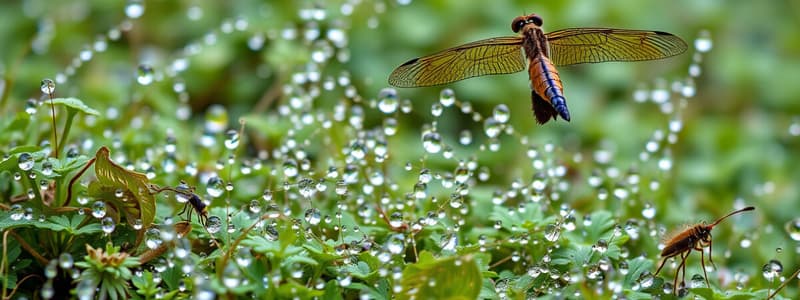Podcast
Questions and Answers
What are the characteristics (properties) of life?
What are the characteristics (properties) of life?
Characteristics of life include organization, metabolism, homeostasis, growth, reproduction, response to stimuli, and adaptation.
In ecology, a ______ is defined as a group of the same species in the same area.
In ecology, a ______ is defined as a group of the same species in the same area.
population
Which of the following factors cause population increase? (Select all that apply)
Which of the following factors cause population increase? (Select all that apply)
- Immigration (correct)
- Sterility
- Loss of a predator (correct)
- Deaths
What curve represents population growth that is limited by resources?
What curve represents population growth that is limited by resources?
Exponential growth indicates that resources are limited.
Exponential growth indicates that resources are limited.
What is carrying capacity?
What is carrying capacity?
What type of interaction involves one organism hunting and consuming another for food?
What type of interaction involves one organism hunting and consuming another for food?
What are the three types of symbiosis?
What are the three types of symbiosis?
Flashcards are hidden until you start studying
Study Notes
Characteristics of Ecology
- Ecology is the study of interactions between organisms and their environment.
- Key levels of organization: Organism, Population, Community, Ecosystem, Biome, Biosphere.
Factors in Population Dynamics
- Biotic Factors: Living components affecting populations, like competition and predation.
- Abiotic Factors: Non-living components, such as climate, soil, and water.
Population Growth Models
-
Exponential Growth (J Curve):
- Occurs when resources are unlimited.
- Characterized by rapid population increase, typical in species like bacteria and humans.
-
Logistic Growth (S Curve):
- Population grows until it reaches carrying capacity, then stabilizes due to limited resources.
- Carrying capacity refers to the maximum population sustainable in an environment.
Population Influencing Factors
- Increase: Births, immigration, expanding territories, technological advancements, decreasing predators.
- Decrease: Deaths, emigration, resource depletion, sterility, introduction of predators.
Predator-Prey Dynamics
- Changes in predator and prey populations are interdependent; increase in prey leads to increased predator populations, and vice versa.
Organismal Interactions
- Predation: One organism hunts another for nourishment.
- Herbivory: Consumption of plants by organisms.
- Symbiosis: Close interactions between different species, beneficial to one or both.
Types of Symbiotic Relationships
- Mutualism (+,+): Both species benefit, such as pollinators and flowering plants.
- Commensalism (+,0): One species benefits while the other is unaffected.
- Parasitism (+,-): One organism benefits at the expense of the other.
Community Ecology Concepts
- Competition: Organisms compete for limited resources such as food, water, and space.
- Keystone Species: A species that has a disproportionately large effect on its environment relative to its abundance.
Succession in Ecosystems
- Primary Succession: Development of an ecosystem in an area with no previous soil, starting with pioneer species.
- Secondary Succession: Recovery of an ecosystem after a disturbance, usually faster due to existing soil.
Trophic Levels and Energy Flow
- Autotrophs: Producers that create energy (e.g., plants).
- Heterotrophs: Consumers that obtain energy by eating others.
- Detritivores: Organisms that consume decomposing organic matter.
- Biomass Pyramid: Illustrates the energy or biomass at each trophic level.
Environmental Issues
- Bioaccumulation: Build-up of substances, like pesticides, in an organism over time.
- Biomagnification: Increase of toxic substances in organisms at higher trophic levels.
- Climate Change: Alteration of global weather patterns due to human activities.
- Biodiversity: Variety of life in an ecosystem, crucial for resilience and ecological balance.
- Pollution: Introduction of harmful substances into the environment, affecting health and ecosystems.
Conservation Efforts
- Overexploitation: Excessive use of species leading to population decline.
- Habitat Destruction: Loss of habitats due to human activities, impacting biodiversity.
- Edge Effects: Changes in population or community structures that occur at the boundary of two habitats.
- Eutrophication: Nutrient overload in water bodies leading to excessive plant growth and oxygen depletion.
Climate Terms
- Carbon Source: Processes that release more carbon than they absorb.
- Carbon Sink: Natural environments that absorb and store carbon dioxide from the atmosphere.
Exam Preparation Suggestions
- Review definitions and implications of ecological terms.
- Understand population dynamics and graphs related to predator-prey relationships.
- Familiarize with types of symbiotic interactions and their ecological impacts.
- Study key ecological concepts such as succession, trophic levels, and environmental issues.
Studying That Suits You
Use AI to generate personalized quizzes and flashcards to suit your learning preferences.




